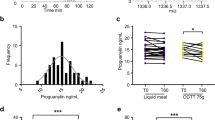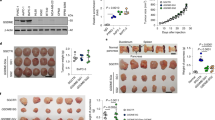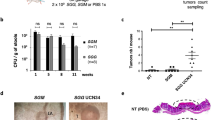Abstract
The secreted phospholipase A2 type IIA (Pla2g2a) gene was previously identified as a modifier of intestinal adenoma multiplicity in ApcMin/+ mice. To determine if intestinal secreted phospholipase A2 (sPLA2) activity was also attenuated in susceptible strains, we developed a sensitive assay to directly quantitate sPLA2 activity in the murine intestinal tract utilizing a fluorescent BODIPY-labeled phospholipid substrate. Here, we report assay conditions that distinguish between secreted and cytosolic PLA2 enzyme activities in extracts of intestinal tissue. The small intestine exhibited higher activity levels than the large intestine. Consistent with predictions from the sPLA2-IIA gene sequence in inbred strains, we detected low levels of enzyme activity in inbred strains containing sPLA2-IIA mutations; these strains were also associated with greater numbers of intestinal polyps. Additionally, the assay was able to distinguish differences in levels of sPLA2 activity between neoplasia-resistant strains, which were then shown by sequencing to carry variant wild-type sPLA2-IIA alleles. Immunohistochemical analyses of intestinal tissues were consistent with sPLA2-IIA activity levels. This approach enables further studies of the mechanisms of sPLA2 action influencing the development and tumorigenesis of the small intestine and colon in both mice and humans.
This is a preview of subscription content, access via your institution
Access options
Subscribe to this journal
Receive 50 print issues and online access
$259.00 per year
only $5.18 per issue
Buy this article
- Purchase on Springer Link
- Instant access to full article PDF
Prices may be subject to local taxes which are calculated during checkout







Similar content being viewed by others
References
Balsinde J and Dennis EA . (1996). J. Biol. Chem., 271, 31937–31941.
Balsinde J, Winstead MV and Dennis EA . (2002). FEBS Lett., 531, 2–6.
Cormier RT, Bilger A, Lillich AJ, Halberg RB, Hong KH, Gould KA, Borenstein N, Lander ES and Dove WF . (2000). Oncogene, 19, 3182–3192.
Cormier RT, Hong KH, Halberg RB, Hawkins TL, Richardson P, Mulherkar R, Dove WF and Lander ES . (1997). Nat. Genet., 17, 88–91.
Dahim M, Mizuno NK, Li X-M, Momsen WE, Momsen MM and Brockman HL . (2002). Biophys. J., 83, 1511–1524.
Dennis EA . (1997). Trends Biochem. Sci., 22, 1–2.
Dietrich WF, Lander ES, Smith JS, Moser AR, Gould KA, Luongo C, Borenstein N and Dove W . (1993). Cell, 75, 631–639.
Farber SA, Olson ES, Clark JD and Halpern ME . (1999). J. Biol. Chem., 274, 19338–19346.
Farber SA, Pack M, Ho SY, Johnson ID, Wagner DS, Dosch R, Mullins MC, Hendrickson HS, Hendrickson EK and Halpern ME . (2001). Science, 292, 1385–1388.
Gelb MH, Jain MK and Berg OG . (1994). FASEB J., 8, 916–924.
Gelb MH, Jain MK, Hanel AM and Berg OG . (1995). Annu. Rev. Biochem., 64, 653–688.
Gould KA, Dietrich WF, Borenstein N, Lander ES and Dove WF . (1996). Genetics, 144, 1769–1776.
Gould KA and Dove WF . (1997). Proc. Natl. Acad. Sci. USA, 94, 5848–5853.
Hara S, Kudo I, Chang HW, Matsuta K, Miyamoto T and Inoue K . (1989). J. Biochem. (Tokyo), 105, 395–399.
Hendrickson HS, Hendrickson EK, Johnson ID and Farber SA . (1999). Anal. Biochem., 276, 27–35.
Ho IC, Arm JP, Bingham 3rd CO, Choi A, Austen KF and Glimcher LH . (2001). J. Biol. Chem., 276, 18321–18326.
Huang Z, Payette P, Abdullah K, Cromlish WA and Kennedy BP . (1996). Biochemistry, 35, 3712–3721.
Kennedy BP, Payette P, Mudgett J, Vadas P, Pruzanski W, Kwan M, Tang C, Rancourt DE and Cromlish WA . (1995). J. Biol. Chem., 270, 22378–22385.
Kim YJ, Kim KP, Han SK, Munoz NM, Zhu X, Sano H, Leff AR and Cho W . (2002a). J. Biol. Chem., 277, 36479–36488.
Kim YJ, Kim KP, Rhee HJ, Das S, Rafter JD, Oh YS and Cho W . (2002b). J. Biol. Chem., 277, 9358–9365.
Kirtane BM and Mulherkar R . (2002). J. Biosci., 27, 489–494.
Koduri RS, Gronroos JO, Laine VJ, Le Calvez C, Lambeau G, Nevalainen TJ and Gelb MH . (2002). J. Biol. Chem., 277, 5849–5857.
Koratkar R, Pequignot E, Hauck WW and Siracusa LD . (2002). Cancer Res., 62, 5413–5417.
Koratkar R, Silverman KA, Pequignot E, Hauck WW, Buchberg AM and Siracusa LD . (2004). Genomics, 84, 844–852.
Lio YC, Reynolds LJ, Balsinde J and Dennis EA . (1996). Biochim. Biophys. Acta., 1302, 55–60.
MacPhee M, Chepenik KP, Liddell RA, Nelson KK, Siracusa LD and Buchberg AM . (1995). Cell, 81, 957–966.
Mulherkar R, Desai SJ, Rao RS, Wagle AS and Deo MG . (1991). Histochemistry, 96, 367–370.
Mulherkar R, Rao R, Rao L, Patki V, Chauhan VS and Deo MG . (1993). FEBS Lett., 317, 263–266.
Murakami M and Kudo I . (2002). J. Biochem. (Tokyo), 131, 285–292.
Murakami M, Nakatani Y and Kudo I . (1996). J. Biol. Chem., 271, 30041–30051.
Rouault M, Bollinger JG, Lazdunski M, Gelb MH and Lambeau G . (2003). Biochemistry, 42, 11494–11503.
Scott DL, Otwinowski Z, Gelb MH and Sigler PB . (1990). Science, 250, 1563–1566.
Silver LM . (1995). Mouse Genetics; Concepts and Applications. Oxford University Press: New York.
Six DA and Dennis EA . (2000). Biochim. Biophys. Acta., 1488, 1–19.
Valentin E, Ghomashchi F, Gelb MH, Lazdunski M and Lambeau G . (1999). J. Biol. Chem., 274, 31195–31202.
Valentin E and Lambeau G . (2000). Biochim. Biophys. Acta., 1488, 59–70.
Acknowledgements
We thank Dr EA Dennis for critical suggestions regarding this research, Dr R Mulherkar for graciously providing the sPLA2-IIA antibody and Dr H Alder for sequencing with the KCC Nucleic Acids Facility. This work was supported in part by US NIH Grants RO1 DK060369 (SAF), PO1CA72027 (LDS and AMB) and RO1 CA89560 (LDS and AMB) and by a Pew's Scholar's Award to SAF.
Author information
Authors and Affiliations
Corresponding author
Rights and permissions
About this article
Cite this article
Markova, M., Koratkar, R., Silverman, K. et al. Diversity in secreted PLA2-IIA activity among inbred mouse strains that are resistant or susceptible to ApcMin/+ tumorigenesis. Oncogene 24, 6450–6458 (2005). https://doi.org/10.1038/sj.onc.1208791
Received:
Revised:
Accepted:
Published:
Issue Date:
DOI: https://doi.org/10.1038/sj.onc.1208791
Keywords
This article is cited by
-
The Secretory Phospholipase A2 Gene is Required for Gastroesophageal Reflux-Related Changes in Murine Esophagus
Journal of Gastrointestinal Surgery (2009)



